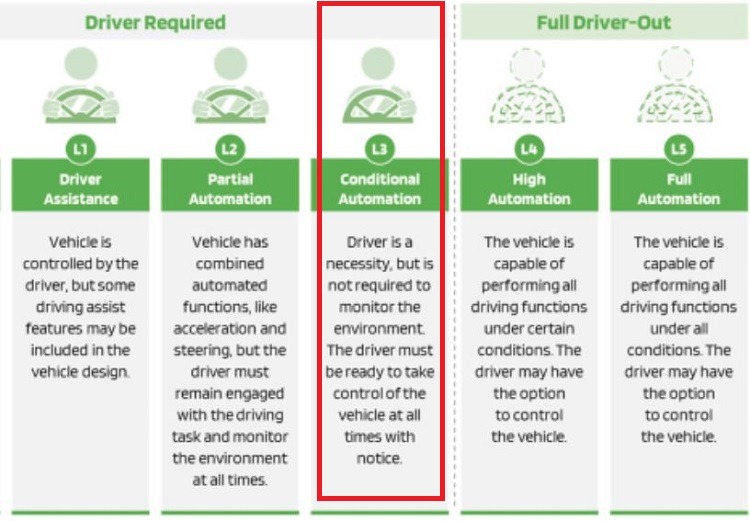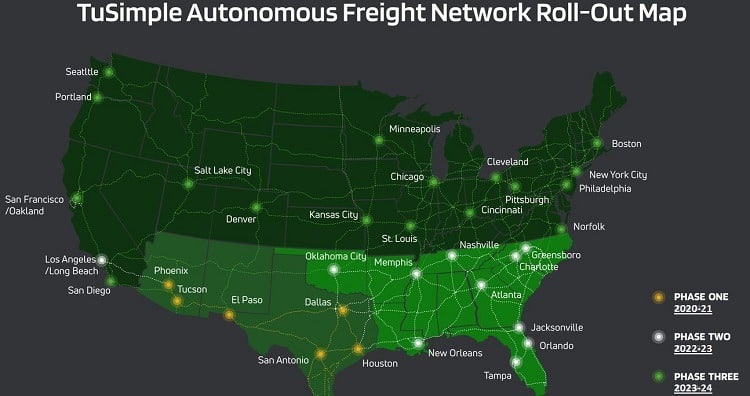Is Self-Driving Truck Stock TuSimple a Buy?
Table of contents

The low-hanging fruit of autonomous driving would have to be semi trucks. They’re predominantly driven on highways which present fewer challenging conditions than city driving. They ply the same routes, over and over. (Nearly 80% of truck freight goods hauled in the U.S. are moved via 10% of the nation’s trade corridors.) And the shortage of drivers, as well as increased usage of trucking as retail moves online, demand a technology solution.
Trucking represents approximately 80% of the U.S. freight market. Labor costs now represent 43% of total per mile semi-truck operating costs, a ten percentage point increase since 2012. It’s also becoming an increasingly dangerous occupation with injuries from crashes involving large trucks doubling from 2009 to 2019. The autonomous trucking investment thesis is plain to see. What’s not so obvious is which company(ies) will succeed in bringing an autonomous truck to market.
How We Imagine Autonomous Driving
In bee school, they teach MBAs how to think critically using case studies. A problem is presented with little accompanying information, and the bright minds of tomorrow imagine what the future looks like. If we were to guess how autonomous driving unfolds, it would be in stages that accommodate social pressures.
It starts with ADAS acting as a glorified cruise control mechanism. It then moves all the way to Level 3 autonomy which means there will always be a human driver ready to take over. To make everyone feel safe, the human will be physically in the truck cab for a while. The advantage for companies will be that the trucks can operate pretty much 24-7, with the driver studying for a new occupation. Then, the physically present driver turns into a remotely present driver, and the rest is history. In other words, a key milestone will be Level 3 automation where a driver is still present:

One reason we think that’s the path forward is because of all the regulations surrounding trucking.
With the invention of meth, drivers realized they could also run 24-7, provided they could successfully manage the accompanying paranoia and jaw-grinding. (Anyone remember mini-thins?) That’s when government stepped in and started mandating rules. For example, semi-truck drivers are legally limited to 11-hour shifts. Companies that are realistic about implementing autonomous trucking will likely consider:
- Regulatory needs – getting the rules to change regarding consecutive hours driven once late-stage autonomy arrives.
- The progression of autonomy through the various stages and how their technology plans to address each stage.
- The progress made towards actual use of their technology on the road. None of that “build it and they will come” rubbish.
This brings us to a company that’s taken our vision of autonomous trucking and promptly chucked it in the trash. TuSimple has decided the way forward is to skip right to Level 4 Automation. They’ve now filed for an initial public offering (IPO), giving investors what appears to be one of the first pure-play autonomous trucking stocks. The company is what some Chinese people endearingly refer to as “an egg” – white on the outside, yellow on the inside.
About TuSimple Stock
Founded in 2015, San Diego startup TuSimple has taken in $648 million in disclosed funding from loads of big names – NVIDIA, UPS, Sequoia, Volkswagen, Navistar, and Goodyear – along with lots of Chinese investors. That’s created some problems according to a recent piece by TechCrunch which notes that the Committee on Foreign Investment in the United States (CFIUS) has asked for the company to clarify some of their investor connections.
Prior to the IPO, TuSimple made obvious efforts to distance themselves from such political complexities. The company started out going the “VIE structure in the Cayman Islands” route, then quickly distanced themselves from it. According to the TuSimple S-1, no VIE structures are in use anymore, and the Cayman Islands connection is a thing of the past. So, provided they can get past the CFIUS inquiry, it should be a non-issue.
The same TechCrunch article talks about “50 of its Level 4 semi-trucks hauling in the U.S. and 20 operating in China,” and they’ve been doing testing in Arizona since 2018. (TuSimple says 43 states allow L4 semi-truck testing and 24 states allow L4 autonomous semi-truck commercial deployment.) Says the S-1, “In 2021, we expect to demonstrate our semi-truck operating on public roads without a safety driver or passenger on-board.” They’re already operating autonomous trucks with a few humans on board, and this year the humans will go away. They’ll then begin offering autonomous trucking as a service.

Fleet Transports as a Service
TuSimple expects “L4 autonomous semi-trucks to be able to operate in excess of 22 hours per day,” which implies no humans on board. TuSimple believes that a “ramp-to-ramp” solution which still requires a human would decrease scalability, increase the chances of accidents, and incur significant drayage and incremental real estate costs. Their business model is to provide an entire network of autonomous driving infrastructure that can be utilized in two ways. The first would be to offer “autonomous freight capacity as a service,” something that’s fairly self-explanatory. The second would be to sell autonomous trucks.
Selling Autonomous Trucking Capabilities
TuSimple likes to talk about the 5,700 plus autonomous truck reservations they received in four months, but the fine print tells a different story. Around 75% of their reservations were made by commercial fleet operators “who are also equity investors in our company,” says TuSimple, noting that any of the 5,700 “reservations” can be canceled at any time. In other words, it’s just like companies that try and make a big deal out of “memorandums of understanding.” If it’s not legally binding, it means very little to investors. TuSimple intends to begin filling reservations “over a multi-year period commencing in 2024,” so you’ll have to wait a while to see if these claims hold water.
In the meantime, revenues are starting to trickle in. To date, all their revenues recognized have been from freight capacity services provided through the TuSimple Capacity service model. These are as follows:
- 2018 – $9,000
- 2019 – $710,000
- 2020 – $1,843,000
An optimist would point out the three-year compound-annual-growth-rate (CAGR) of +1,432%, while a pessimist would say they’ve barely cleared $2.5 million revenues during the company’s six years in existence. At any rate, we’re stoked they actually have some revenues from selling their service.
The Leader in Autonomous Trucking?
Here’s why TuSimple says they’re a leader in autonomous trucking.
- First to announce partnerships with OEMs via our Navistar and TRATON partnerships
- First to announce an investment from a major carrier when UPS invested in our company in 2019
- First to establish a near highway terminal for autonomous commercial freight operations
- First and only to demonstrate L4 autonomous semi-truck driving on both surface streets and highways
- First L4 autonomous semi-truck to haul a paid freight load
Usually, you’ll get a lot of disputes when you make claims like this, but let’s assume they’re the leader. If so, here are who the leader in autonomous trucking thinks their competitors are.
Other Autonomous Trucking Companies
When a company is the first of its kind to IPO, this often results in other companies of their ilk following suit. LiDAR is a great example of this phenomenon. First Velodyne, then Luminar, Innoviz, and Aeva. So, let’s take a quick look at what TuSimple’s competitors have been up to. These names are from the horse’s mouth, with the S-1 stating, “some examples of our competitors include Waymo, Aurora, Embark, and Kodiak.”
- Waymo – We recently covered them in our piece on The Autonomous Vehicle Companies in the Self-Driving Race. Raised $3 billion so far and has a deal with Daimler (better known as Mercedes-Benz) to develop Level 4 autonomous technology for class 8 semi-trucks.
- Aurora – Sitting at a $10 billion valuation with $1.1 billion raised. Last round was $400 million in Dec 2020 led by Uber. Says an article by the WSJ, Aurora is working with “certain models of Paccar’s Peterbilt and Kenworth brand trucks, with the goal of bringing self-driving trucks to market in the next several years.”
- Embark Trucks – Total funding at $117 million and hasn’t raised since Sept 2019. Website says, “already moving freight for five Fortune 500 companies in the southwest U.S.” Working with Arizona Department of Transportation to develop “automated trucking highway work zones,” according to Forbes piece last week.
- Kodiak Robotics – Raised a total of $40 million in disclosed funding, all of which came in the form of an August 2018 Series A. In 2019, they began their first deliveries in Texas. Not much has been said following that announcement.
Then there’s the electric elephant in the room, Tesla, which expects that semi trucks will be the first Tesla vehicles to achieve full autonomy. There are also other names to consider, some of which we touched on in our 2017 piece titled Driverless Trucking Heats Up in 2017. Here’s what some additional driverless trucking companies have been up to.
- Starsky Robotics – The “first company to make driverless trucks a reality” closed their doors in May 2020 after a failed funding round.
- Einride – Autonomous and electric offering that’s still moving forward with a $10 million round raised in October 2020 bringing total disclosed funding to $42.3 million.
- Peloton Technology – Hasn’t raised since 2017 but appears to be alive after a recent Rona-related landlord scuffle. Supposed to be commercializing “platooning” where trucks are connected and operate as mini convoys. Last press release was in October 2019.
Retail investors can also take the less risky approach and assume that all trucking companies will move to autonomous driving eventually to enjoy a 50% reduction in costs (an estimate from TuSimple). In that case, just go buy a portfolio of trucking stocks and wait.
Conclusion
Since TuSimple has decided not to go the VIE structure route, the company is on our radar. We’re particularly interested in the revenues starting to emerge following their first “paid freight load.” Given the hype around vehicle autonomy, we’re going to let the dust settle following their IPO and take another look when quarterly revenues show a growth rate that is consistent with their “freight as a service” business model coming online.
Should the IPO go through as planned, shares of TuSimple will trade under the ticker TSP.
We’re presently holding 2 robotics stocks and 1 robotics ETF. Want us to name names? Become a Nanalyze Premium annual subscriber and find out today.

Sign up to our newsletter to get more of our great research delivered straight to your inbox!
Nanalyze Weekly includes useful insights written by our team of underpaid MBAs, research on new disruptive technology stocks flying under the radar, and summaries of our recent research. Always 100% free.















